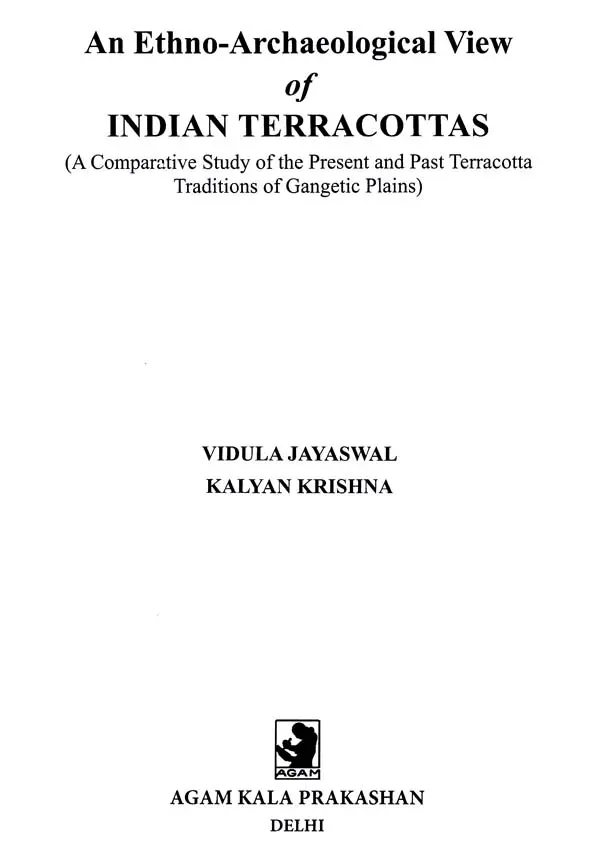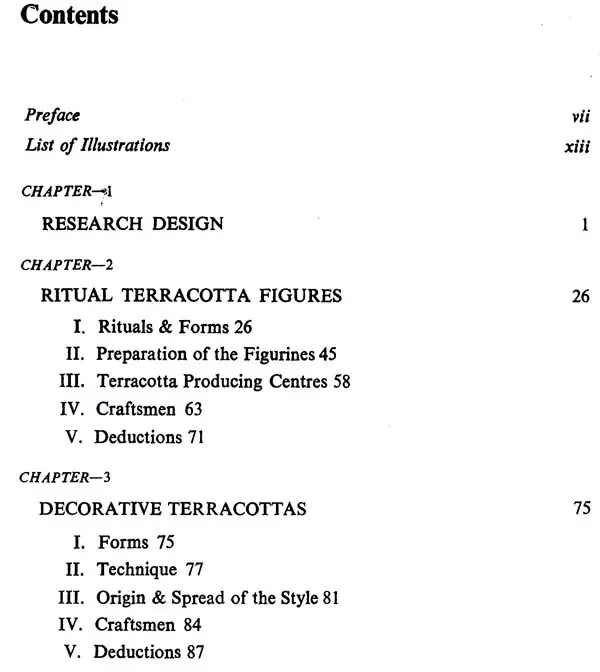
An Ethno-Archaeological View of Indian Terracottas
Book Specification
| Item Code: | UAM212 |
| Author: | Vidula Jayaswal and Kalyan Krishna |
| Publisher: | Agam Kala Prakashan, Delhi |
| Language: | English |
| Edition: | 2022 |
| ISBN: | 9789392556128 |
| Pages: | 213 (Throughout B/W Illustrations) |
| Cover: | HARDCOVER |
| Other Details | 10.00 X 7.50 inch |
| Weight | 550 gm |
Book Description
Significance for the use of ethnographic analogues to the interpretation of the archaeological situations is well established for quite some time now. But this important line of inquiry has remained more or less unattempted in the studies of ancient Indian history. The present book An Enthno-Archaeology View of Indian Terracottas (A) Comparative study of the present and past terracotta traditions of Gangetic plains), successfully demonstrates the reliability of such a persuit for the interpretation of various aspects of ancient art & craft traditions. In order to have satisfactory grounds for discussions, extensive surveys of the pottery and terracotta producing centers of eastern Uttar Pradesh and Bihar were under taken by the authors of the present book. The ethnographic informations thus, acquired have been incorporated in this book along with a consolidated account of the significant archaeological finds from the Gangetic plains, the area which has the privilege to preserve the remains of occupational history of three thousand years. Comparison of the enthnological deductions with the archaeological parallels reveals some significant explanations and clues for the reconstruction of the historical craftsmanship of clay modelling, which have been presented for the first time. Besides laying the convention for the interpretative archaeology, the book also extends the scope of the studies of ancient crafts much beyond mere identification of themes and some general observations on technique.
Co-author of books Ikat Fabrics of Orissa and Andhra Pradesh and Indian Pigment Painting on Cloth, Dr. Krishna's forthcoming catalogues on the Calico. Museum collections are Indian Costumes and Indian Zari Brocade. He has also done extensive study of Rituals and Paintings of the Vallabhaite Sect, which will shortly appear as monograph.
CLAY has been one of the most popular media of art expression since ancient times. In the Ganga valley itself terracottas, the baked clay figurines have a long continuous history of about three thousand years. Two reasons seem to be particularly responsible for such a popularity of clay modelling. First, it is the elastic character of clay which makes it easy to model and mould; and second, it is perhaps one of the most inexpensive media, almost universally available free of cost in desired quantities to every craftsman. The firing process by which durability is provided to clay objects also does not involve much expenses. Nevertheless, the importance of clay figurines as representing one of the significant culture patterns of the Indian society cannot easily be ignored.
In spite of the free access of raw material to every individual the efficiency in clay modelling seems to be restricted only to a select group of the society. The existing practices in the Ganga valley suggest that all types of modelling and baking of clay by convention and tradition are potters' work. The only exception to this, however, can be seen in the form of hand-modelled figurines of dough and clay, which are prepared by common household women at the time of particular rituals. But then these figurines, in almost all the cases, are used unbaked.
With a view to recording details of living terracotta craft, important pottery producing centres of eastern Uttar Pradesh and Bihar were surveyed by us in the years 1980 and 1981. Confined mainly to Gorakhpur, Deoria districts of Uttar Pradesh, and Bhojpur, Muzaffarpur, Darbhanga, Sitamarhi, Patna, Barh and Gaya districts of Bihar, this survey was initially conducted by the present authors in order to prepare a documentary report on the Terracotta Art of Gorakhpur and Some other Important Centres in Eastern Uttar Pradesh and Bihar (1982) for the Crafts Museum of India, New Delhi, While examining the data thus collected, it was realized that some of the observations may provide useful clues to the interpretation of baked clay figurines found from various archaeological sites. This inspired the first author to seek parallels between the present day terracotta making traditions and those of the ancient periods. In pursuit of this objective, not only the archaeological collections from various sites of the Gangetic valley were examined carefully, but we also extended our survey of recording present day practices to Varanasi, Ajamgarh and Ballia districts of Uttar Pradesh, and Hazaribagh, Ranchi and Daltonganj districts of Bihar, in the years 1983 and 1984. Besides studying some new centres, we also deemed it necessary to revisit some of the important centres studied earlier. This became essential in view of our new line of enquiry, for which we had to have details of a number of questions related to the manufacturing processes of the terracotta figurines and mechanics of their dispersal on one hand, and various aspects of the socio-economic conditions of their makers on the other. Thus, two sets of data were collected for the present study, i.e., (i) the ethnographic details acquired by interviewing more than eight hundred potters and by studying one hundred and thirty-four pottery producing centres, and (ii) informations relating to archaeological material obtained by personal examination of terracotta collections coming from important protohistoric and early historic sites of the Ganga valley. They both form the basis of the present monograph.
**Contents and Sample Pages**


















